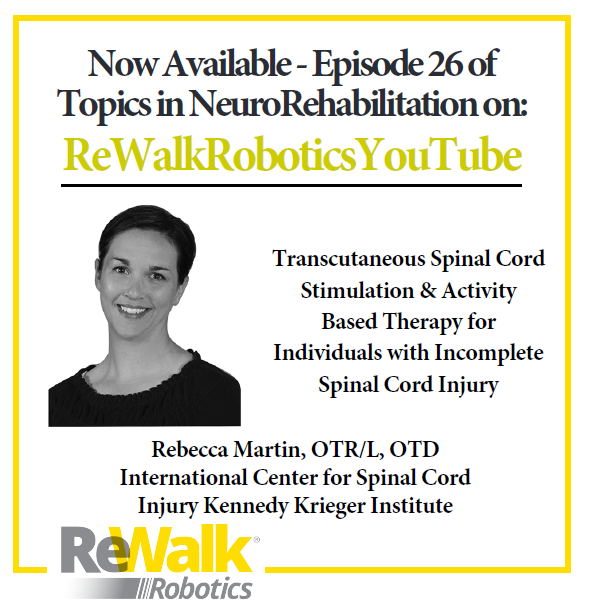News & Events

What’s new in the world of Spinal Cord Stimulation research?
Watch this month’s episode of Topics in NeuroRehabilitation to hear from Dr. Rebecca Martin, OTR/L, OTD from the International Center for Spinal Cord Injury at the Kennedy Krieger Institute as she discusses recent research examining the use and feasibility of transcutaneous spinal cord stimulation (TSCS) to supplement traditional gait training rehabilitation for individuals with motor incomplete spinal cord injuries. This field of research shows exciting advances that can lead to improvements in walking speed, endurance, and gait quality, with some interesting secondary benefits including improvements in bowel and bladder function and reductions in pain.
In case you missed any of our previous episodes, you can check out the full Topics in NeuroRehab playlist available on YouTube, here.
To learn more about Rebecca’s research and some of the spinal cord stimulation resources she mentions in her talk, please follow the links below:
- International Center for Spinal Cord Injury: http://spinalcordrecovery.org/
- McHugh, Liza V., et al. “Feasibility and utility of transcutaneous spinal cord stimulation combined with walking-based therapy for people with motor incomplete spinal cord injury.” Spinal Cord Series and Cases 6.1 (2020): 1-9. https://www.nature.com/articles/s4139…
- Lang, Catherine E., et al. “Observation of amounts of movement practice provided during stroke rehabilitation.” Archives of physical medicine and rehabilitation 90.10 (2009): 1692-1698. https://www.sciencedirect.com/science...
- National Spinal Cord Injury Statistical Center. (2013). Spinal cord injury: Facts and figures at a glance. Retrieved May 23, 2013 from https://www.nscisc.uab.edu/PublicDocu…
Additional Resources:
- Anderson KD. Targeting recovery: Priorities of the spinal cord-injured population. J Neurotrauma. 2004 Oct;21(10):1371-83 Harkema S, Behrman A, Barbeau H. Evidence-based therapy for recovery of function after spinal cord injury. Handbook for Clinical Neurology.2012;109(3):261-274.
- Labruyere R, van Hedel HJ. Strength training versus robot-assisted gait training after incomplete spinal cord injury: a randomized pilot study in patients depending on walking assistance. J of Neuroeng Rehab.2014;11(4).
- Behrman AL, Lawless-Dixon AR, Davis SB, Bowden MG, Nair P, Phadke C, Hannold EM, Plummer P, Harkema SJ. Locomotor training progression and outcomes after incomplete spinal cord injury. Phys Ther. 2005;85:1356-1371
- Behrman AL, Harkema SJ. Locomotor training after human spinal cord injury: a series of case studies. Phys Ther. 2000; 80:688-700.
- Hofstoetter US, Krenn M, Danner, SM, Hofer C, Kern H, McKay WB, Mayr W, Minassian K. Augmentation of voluntary locomotor activity by transcutaneous spinal cord stimulation in motor-incomplete spinal cord-injured individuals. Artif Organs. 2015; 39(10):176-186.
- Harkema SJ. Plasticity of interneuoronal networks of the functionally isolated human spinal cord. Brain Research Review.2008;57:255-264.
- Gorodnichev RM, Pivovarova EA, Puhov A, Moiseev SA, Savochin AA, Moshonkina TR, Chsherbakova NA, Kilimnik VA, Selionov VA, Kozlovskaya IB, Edgerton VR, Gerasimenko YP. Transcutaneous electrical stimulation of the spinal cord: a noninvasive tool for the activation of stepping pattern generators in humans. Human Phys. 2012;38(2):158-167.
- Hofstoetter US, Mckay WB, Tansey KE, Mayr W, Kern HK. Modification of spasticity by transcutaneous spinal cord stimulation in individuals with incomplete spinal cord injury. J Spinal Cord Med. 2014;37(2):202-211.
- Minassian K, Hofstoetter US, Danner SM, Mayr W, Bruce JA, McKay WB, Tansey KE. Spinal rhythm generation by step-induced feedback and transcutaneous posterior root stimulation in complete spinal cord-injured individuals. Neurorehabil and Neural Repair. 2015; 29 (5): 395-495.
- Gerasimenko YP, Lu DC, Modaber M, Zdunowski S, Gad P, Sayenko DG, Morikawa E, Haakana P, Ferguson AR, Roy RR, and Edgerton VE, Noninvasive reactivation of motor descending control after paralysis. Journal of Neurotrauma. 2015.



